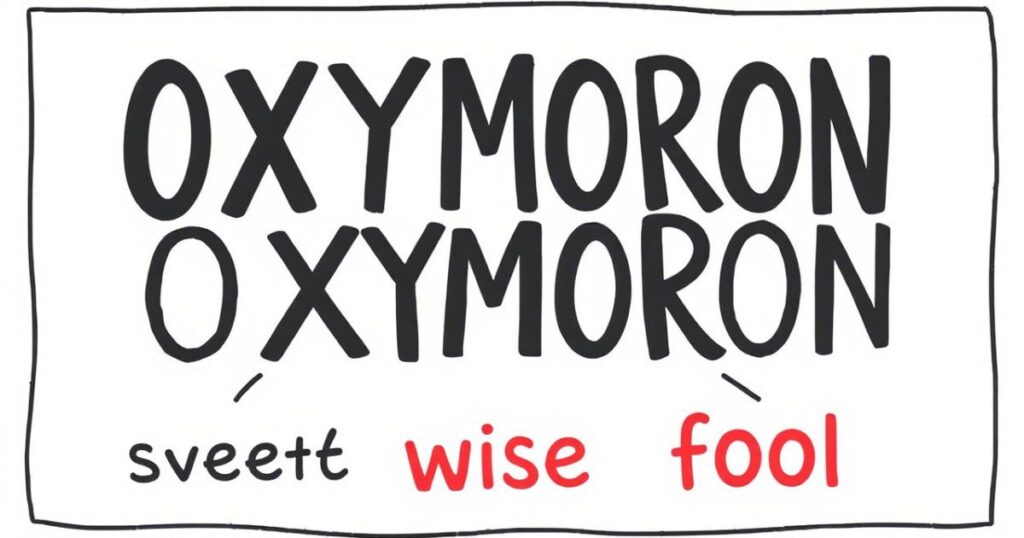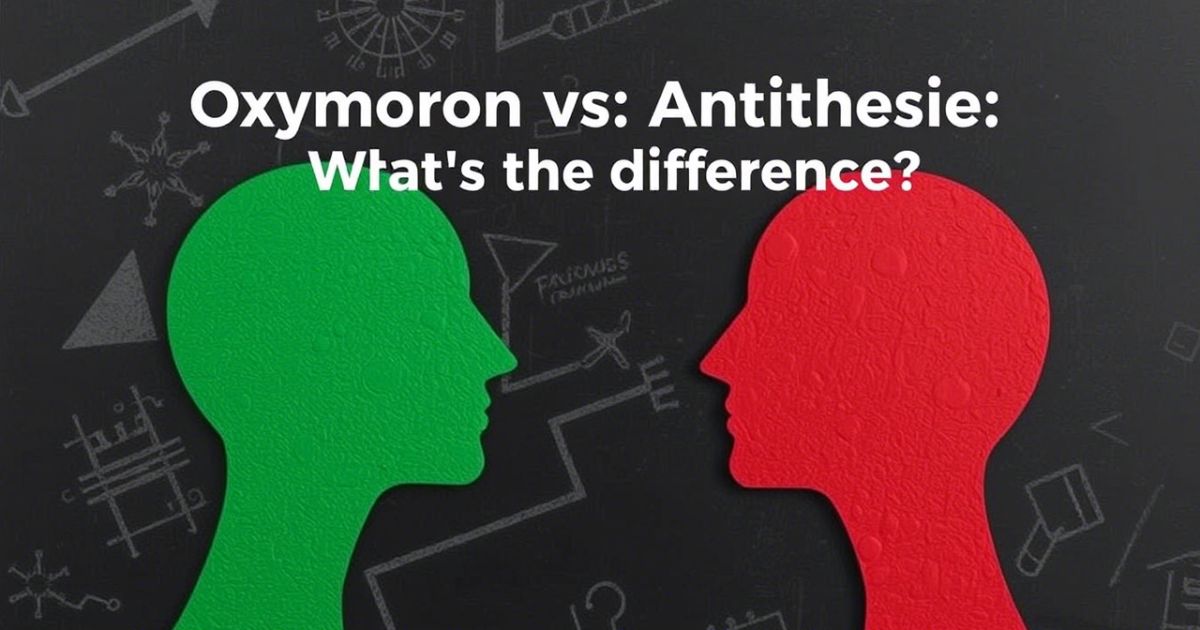Have you ever wondered how certain phrases make such a lasting impact? That’s the magic of Oxymoron vs Antithesis. While both create striking contrasts, they do so in unique ways. An oxymoron blends two seemingly opposite terms, like “deafening silence,” to create intrigue. In contrast, antithesis pits opposing ideas side by side, such as “love vs. hate,” to highlight their differences.
Understanding what is antithesis and what is oxymoron is essential to mastering these powerful tools. The difference between antithesis and oxymoron comes down to their structure, and this knowledge can transform your writing. Oxymoron vs Antithesis has the power to reshape your tone and meaning, adding depth and clarity. Embrace these devices to elevate your message and captivate your audience.
What is Oxymoron?

An oxymoron is a literary device that pairs contradictory terms to create a striking expression, like bittersweet or deafening silence, adding depth, irony, or complexity to the message or tone.
Examples of Oxymoron
- Bittersweet
- Jumbo shrimp
- Living dead
- Deafening silence
- Alone together
- Youthful wisdom
- Army of one
- Gentle roar
- Burning ice
- Painfully beautiful
Origins of “Oxymoron”
The term “oxymoron” originates from the Greek words “oxys” (sharp) and “moros” (foolish), forming a paradoxical expression that literally means “sharply foolish.” This concept was explored in Ancient Greek literature and later expanded upon in Roman rhetoric by thinkers like Cicero. Over time, it became a staple literary device in poetry, speeches, and creative writing, often used to highlight complexity or provoke thought through contradiction.
What is Antithesis?
Antithesis is a powerful rhetorical device that places opposing ideas in a balanced structure to create contrast and emphasize meaning. It’s often used in persuasive writing, speeches, and literature to sharpen the message or reveal deeper complexity. Phrases like “speech is silver, silence is gold” or “float like a butterfly, sting like a bee” are classic examples of antithesis.
Examples of Antithesis
- Best of times, worst of times
- To err is human, to forgive divine
- Speech is silver, silence is gold
- Float like a butterfly, sting like a bee
- Love vs. marriage
- Light vs. darkness
Origins of Antithesis
The concept of antithesis dates back to Ancient Greek rhetoric, where it was used to create striking contrasts and highlight opposing ideas. Prominent figures like Aristotle and Cicero employed antithesis in their works to persuade and provoke thought. Over time, it became a key element in literary and rhetorical traditions, with Shakespeare famously using it to emphasize themes of conflict and contrast in his plays. Understanding Oxymoron vs Antithesis can enhance your ability to effectively convey complex ideas and make your writing more impactful.
Oxymoron vs Antithesis: The Differences
While both oxymoron and antithesis involve the use of contradictory ideas, they differ in structure and purpose. An oxymoron combines two opposing words within a single expression, like “bittersweet” or “deafening silence,” creating a compact paradox. On the other hand, antithesis contrasts larger opposing ideas or phrases in a balanced structure, such as “best of times, worst of times,” to emphasize differences and create clarity. Understanding Oxymoron vs Antithesis allows writers to choose the most effective technique for adding depth, contrast, and impact to their work.
| Feature | Oxymoron | Antithesis |
| Definition | A figure of speech that combines two opposing words. | A rhetorical device that contrasts opposing ideas or phrases. |
| Structure | A single contradictory expression or phrase. | A balanced structure with contrasting ideas or phrases. |
| Example | “Bittersweet” or “Living dead” | “Best of times, worst of times” or “Love vs. marriage” |
| Purpose | To highlight a paradox or complexity in a single concept. | To emphasize the contrast between two distinct ideas. |
| Use in Literature | Commonly used to create irony or add depth to a single concept. | Often used to present opposing ideas clearly in literature, speeches, and essays. |
| Length | Typically consists of just two words. | Involves longer phrases or clauses. |
How To Use Oxymoron and Antithesis In Sentences
To use oxymoron, pair two contradictory words to express complexity or irony, like “bittersweet memories”. For antithesis, place opposing ideas in a balanced structure to highlight contrast, such as “love brings joy, but also pain”.
Using Oxymoron
- Use oxymoron to express complex emotions or situations, like “deafening silence” or “painfully beautiful”.
- Combine contradictory terms to create irony or humor, such as “jumbo shrimp” or “silent thunder”.
- Highlight contrasts in character traits or events, for example, “confident uncertainty”.
- Use oxymorons in poetry or creative writing to evoke strong imagery or thought-provoking contradictions.
- Experiment with oxymorons to add depth and complexity to your narrative or dialogue, like “a bittersweet farewell” to capture mixed emotions.
Using Antithesis
- Use antithesis to highlight stark contrasts between two ideas, such as “to be or not to be”.
- Emphasize opposing elements in literary works to create tension or drama, like “love vs. hate”.
- Use balanced phrases to draw attention to differences, for example, “speech is silver, silence is gold”.
- Incorporate antithesis in persuasive writing to strengthen an argument by presenting conflicting viewpoints.
- Use antithesis to make a clear statement, like “the best of times, the worst of times”, which contrasts two extremes.
Both antithesis and oxymoron create contrast, but they do so in different ways. Antithesis juxtaposes opposing ideas in a balanced structure, often to clarify or emphasize differences, like “love vs. hate.” On the other hand, oxymoron combines contradictory terms within a single phrase, such as “bittersweet,” to express complex or ironic situations. Understanding the distinction between Oxymoron vs Antithesis helps writers effectively use each technique to enhance their message and add depth to their writing.
Combining Oxymoron and Antithesis
Combining oxymoron and antithesis can create a powerful contrast that adds depth and complexity to your writing, blending the tension of opposing ideas within a balanced structure.
- Identify the Contrast: Recognize the conflicting elements in your subject matter and decide how you can juxtapose them for maximum impact. Think about the relationship between the ideas you want to explore.
- Balance the Structure: Ensure that the opposition is clear by using antithesis to contrast larger ideas while using oxymoron for smaller, contradictory phrases that add nuance to those ideas.
- Enhance Complexity: Use both techniques together to highlight layers of meaning, for example, contrasting two different viewpoints with antithesis and expressing the irony of each with oxymoron.
- Create Emphasis: When combining oxymoron and antithesis, the contradictory elements should be emphasized, helping to draw attention to the tension and adding depth to your message.
- Use for Irony: Pair oxymorons with antithesis to create ironic moments where the conflict between ideas is so strong, it evokes humor or reflection, like “a peaceful war”.
- Achieve Cohesion: While these techniques create contrast, make sure they still align with your overall theme and message, maintaining clarity and coherence in your writing.
By combining these two literary devices, you can elevate your writing, creating more memorable and thought-provoking content. The balance between contrast and irony in Oxymoron vs Antithesis can make your work more engaging and dynamic.
Examples Of Oxymoron and Antithesis Used In Sentences
Using oxymoron vs antithesis in sentences allows writers to emphasize contrast and irony, adding depth and meaning to their work. Below are some examples showcasing how these devices work in context.
Examples of Oxymoron in Sentences
- The jumbo shrimp at the restaurant were surprisingly small despite the name.
- There was a deafening silence in the room after the announcement.
- The idea of the living dead has intrigued many horror fans for centuries.
- The team celebrated their bittersweet victory, knowing they had lost key players.
- They found themselves alone together in the middle of a bustling city.
- He managed to act naturally during his first live television appearance.
- The country was torn apart by a civil war, despite being founded on ideals of unity.
- The open secret about the office changes spread quickly through the team.
- The concert had a surprisingly small crowd for such a popular artist.
- His jokes were seriously funny, making everyone laugh uncontrollably.
Examples of Antithesis in Sentences
- “It was the best of times, it was the worst of times.”
- “To err is human; to forgive, divine.”
- “Speech is silver, silence is golden.”
- “Float like a butterfly, sting like a bee.”
- “Love vs. marriage: one is a dream, the other a reality.”
- “The pen is mightier than the sword.”
- “Wise vs. foolish: the difference is often in perception.”
- “Easy on the eyes, hard on the heart.”
- “Light vs. darkness: two forces that shape our world.”
- “Passion vs. pain: two emotions that drive human action.”
Related Guide:
Is it Scrapped or Scraped? Let’s Clarify the Confusion
Combined Use of Oxymoron and Antithesis
- The bittersweet victory left the team feeling both elated and defeated.
- She faced a deafening silence amid the noisy arguments around her.
- The living dead roamed the streets, contrasting with the vibrant life around them.
- His seriously funny remarks were in stark contrast to the grim atmosphere in the room.
- The open secret about the surprise party clashed with their unspoken knowledge.
- Their alone together moment felt like a shared solitude amid the crowd.
- The calm chaos of the city was a loud whisper against its usual hustle.
- The small crowd at the event felt like a huge disappointment for the organizers.
- In the deep shadows, they found a bright light of hope shining through.
- The sweet sorrow of parting only magnified the joyful sadness of the reunion.
Common Mistakes to Avoid When Using Oxymoron and Antithesis
When using oxymoron vs antithesis, it’s important to be mindful of how they’re incorporated into your writing. Overusing or misapplying these devices can diminish their effectiveness, making your writing feel forced or awkward.
- Overusing Contradictory Elements: Too many oxymorons or antitheses in one piece can overwhelm the reader and diminish their power.
- Lack of Context: Using these devices without clear context can lead to confusion and misinterpretation.
- Forcing Creativity: Trying to add oxymorons and antitheses where they don’t naturally fit can make the writing sound contrived.
- Using Cliché Phrases: Relying on overused oxymorons or antitheses may make your writing seem predictable and uninspired.
- Inconsistent Tone: Shifting between conflicting ideas too abruptly can disrupt the tone and flow of the writing.
- Misplacement of Ideas: Placing opposing concepts without balancing them can confuse readers and weaken the intended message.
- Ignoring the Message: The contrast in oxymoron and antithesis should serve to emphasize the message, not obscure it.
- Overcomplicating Sentences: Excessive use of oxymorons and antitheses can make sentences unnecessarily complicated and difficult to follow.
- Inappropriate Pairings: Pairing oxymorons or antitheses that don’t logically complement each other can create awkward or unclear imagery.
- Ignoring Clarity: When these literary devices are used too frequently, they can reduce sentence clarity and prevent the reader from understanding the main point.
Be sure to use oxymoron vs antithesis thoughtfully and sparingly to enhance your writing rather than detract from it. Properly balanced, these devices can add depth and intrigue without overwhelming your audience..
Tips for Avoiding These Mistakes

To make the most of oxymoron vs antithesis, it’s essential to use them with intention and care. By following a few practical guidelines, you can ensure these devices enhance your writing instead of making it feel forced or confusing.
- Use Sparingly: Don’t overload your writing with oxymorons and antitheses. A few well-placed examples can create a stronger impact.
- Ensure Clear Context: Always make sure the use of these devices aligns with the overall theme or message of your writing.
- Avoid Forced Phrasing: Let oxymorons and antitheses emerge naturally within the context of your sentence, rather than trying to force them in.
- Choose Original Combinations: Try to come up with fresh, original pairings instead of relying on overused clichés.
- Maintain Consistent Tone: Keep the tone of your writing steady to avoid jarring transitions when contrasting ideas.
- Balance Opposites Thoughtfully: Pair contrasting ideas where they make sense, ensuring both parts of the contrast are given enough weight.
- Clarify the Message: Ensure the use of contrasting elements helps clarify your message, not obscure it.
- Keep Sentences Concise: Avoid making sentences too complex when using oxymorons and antitheses. Brevity can enhance clarity.
- Make Logical Pairings: Ensure the opposing ideas or elements you combine logically fit together to create a meaningful contrast.
- Check for Readability: After writing, step back and check if the sentence is easy to understand or if the contrast is confusing.
By following these tips, you’ll avoid the common pitfalls of overuse and confusion, allowing oxymorons and antitheses to elevate your writing in a thoughtful and effective way.
Where to Use Oxymoron and Antithesis
Oxymoron vs Antithesis can be powerful tools to highlight contrasts and deepen the meaning of your writing. When used appropriately, they create layers of complexity and intrigue, enhancing the depth and impact of your work.
- To Create Tension: Using oxymorons and antitheses can effectively introduce tension between conflicting ideas, enhancing the emotional depth of the piece.
- In Dialogue: These literary devices can add complexity to characters’ emotions, making their thoughts and expressions more interesting.
- In Poetry: Oxymorons and antitheses are frequently used in poetry to highlight contrasts and emphasize a deeper meaning or emotion.
- In Persuasive Writing: By highlighting contradictions, they can underscore important points, making arguments more compelling.
- In Narrative Writing: These devices can be used to contrast characters, settings, or events, offering a richer narrative layer.
- In Speechwriting: Antithesis and oxymorons are often used in speeches to create memorable and impactful phrases that resonate with the audience.
- To Convey Irony: They can help highlight irony by presenting contradictory or paradoxical ideas in a single sentence.
- In Literary Criticism: These devices can be used to analyze themes or conflicts, enhancing the discussion of complex texts.
- In Marketing and Advertising: Catchy slogans sometimes rely on oxymorons or antitheses to draw attention and provoke thought.
- In Satire or Humor: These devices are often used in satire or humor to exaggerate contradictions, making the message more entertaining and engaging.
When used correctly, oxymorons and antitheses can enhance the impact of your writing, making it more dynamic and thought-provoking for your audience.
Where Not to Use Oxymoron and Antithesis

While oxymorons vs antithesis can add depth to your writing, it’s essential to know when not to use them. Overusing or placing them in the wrong context can weaken your message and confuse the reader.
- In Simple or Direct Writing: Avoid using these devices in straightforward, factual writing, as they may complicate the message or detract from clarity.
- In Informal or Casual Writing: Oxymorons and antitheses might come across as overly pretentious or forced in light, informal contexts, where simplicity and clarity are key.
- When the Message is Too Complex: If the core message is already complicated, adding contrasts might make it harder for the reader to understand.
- In Technical Writing: In technical or scientific writing, where precision is essential, contradictions and contrasts can confuse the reader or distort the factual content.
- In Situations Where the Tone Needs to Be Consistent: If your writing needs to maintain a steady, uniform tone, using contrasting ideas can disrupt the flow and tone of the piece.
- In Overly Emotional Contexts: While oxymorons and antitheses can enhance emotional writing, overuse in a highly emotional context might make the writing seem melodramatic or inauthentic.
- When the Audience is Unfamiliar with Literary Devices: If the audience isn’t familiar with these devices, their use may alienate or confuse readers instead of adding depth.
- In Short Sentences or Quick Messages: Short-form writing, like advertisements or social media posts, might not be the best place to use these devices as they require more thought and time to process.
- When Trying to Be Too Clever: Trying too hard to use oxymorons or antitheses just for the sake of it can backfire and make the writing feel contrived.
- When It Disrupts Clarity: If the contrast created by oxymoron or antithesis makes your point unclear or muddles the message, it’s best to avoid them.
By knowing when not to use these devices, you can ensure that your writing remains clear, accessible, and impactful.
FAQ’s
What is the difference between an antithesis and an oxymoron?
The main difference between oxymoron and antithesis lies in structure. Oxymoron vs Antithesis: An oxymoron combines two opposite words in one phrase, while antithesis places two opposing ideas together for emphasis.
What is an example of oxymoron and antithesis?
A good example of oxymoron vs antithesis is “deafening silence” (oxymoron) and “it was the best of times, it was the worst of times” (antithesis). A paradox might be “less is more.”
What are antithesis and examples?
Antithesis is when two contrasting ideas are put together. For example, “love is an endless act of forgiveness” vs “hatred is a poison.”
What is an example of an oxymoron?
An example of oxymoron vs antithesis is “jumbo shrimp.” It combines two opposite terms, creating a unique contrast in one phrase.
What is a perfect example of an oxymoron?
A perfect example of oxymoron vs antithesis would be “bittersweet.” It merges two contradictory feelings into a single expression.
Conclusion
Oxymoron vs Antithesis, both have unique roles in writing. Oxymoron vs Antithesis highlights contrasting ideas, but they do so differently. An oxymoron combines two opposite terms into one expression, like “bittersweet.” On the other hand, antithesis presents two opposite ideas side by side to emphasize contrast, like “best of times, worst of times.” The difference between oxymoron and antithesis lies in structure and how they convey contrast.
Understanding what is antithesis and what is oxymoron helps in using them effectively. The difference between antithesis and oxymoron is clear once you recognize how each plays with contrast. Whether you choose Oxymoron vs Antithesis depends on the tone and complexity you want to achieve. Both devices enrich your writing when used properly, so choose wisely!

Ember Rose is a dedicated administrator with 4 years of experience in efficient operations management and team leadership. Skilled in streamlining workflows and enhancing productivity.

